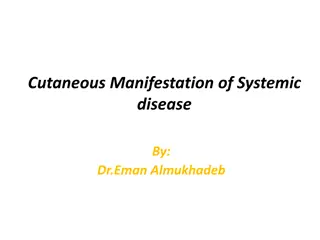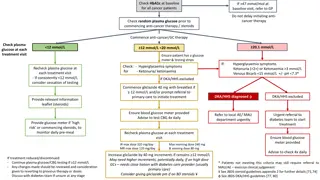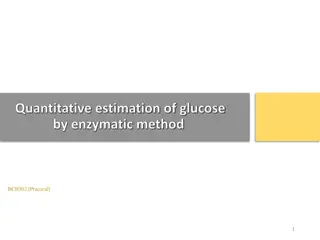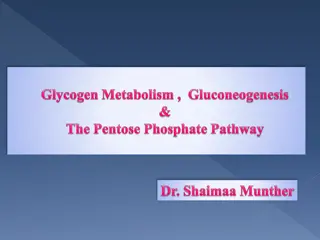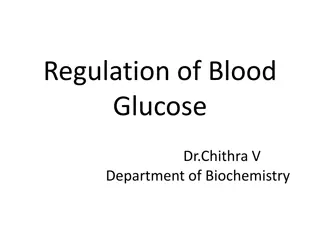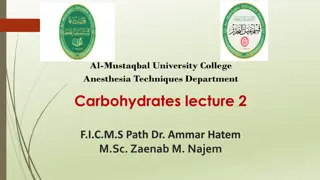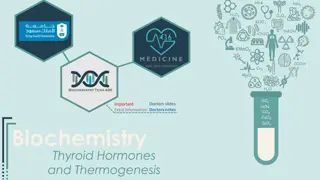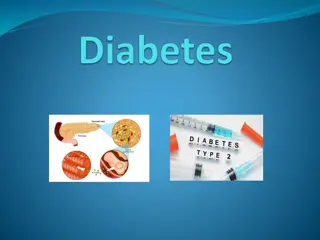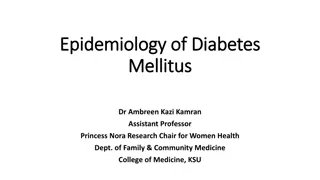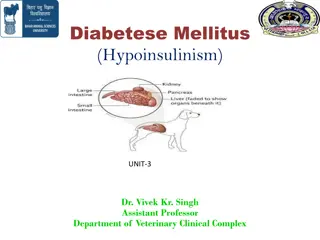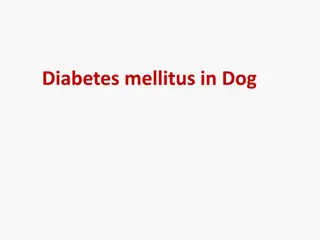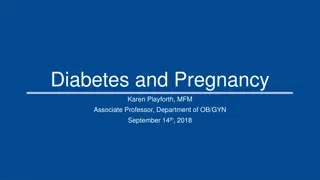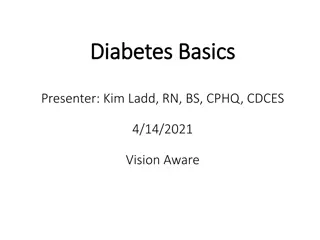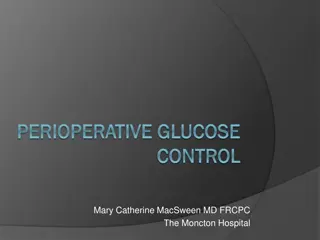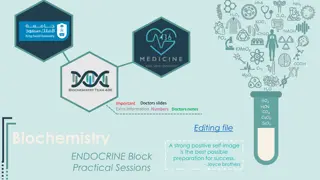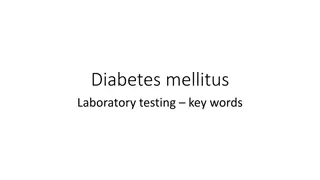
Update on SGLT2 Inhibitors for Diabetes Mellitus Treatment
Learn about the latest advancements in treating diabetes mellitus with SGLT2 inhibitors, including their mechanism of action, benefits, clinical trial insights, and safety concerns. Understand the physiological basis of sodium-glucose co-transporter inhibition and the potential of these inhibitors in managing carbohydrate metabolism for improved patient outcomes.
Download Presentation

Please find below an Image/Link to download the presentation.
The content on the website is provided AS IS for your information and personal use only. It may not be sold, licensed, or shared on other websites without obtaining consent from the author. If you encounter any issues during the download, it is possible that the publisher has removed the file from their server.
You are allowed to download the files provided on this website for personal or commercial use, subject to the condition that they are used lawfully. All files are the property of their respective owners.
The content on the website is provided AS IS for your information and personal use only. It may not be sold, licensed, or shared on other websites without obtaining consent from the author.
E N D
Presentation Transcript
An update on sodium- glucose co transporter-2 inhibitors for the treatment of diabetes mellitus
INTRODUCTION The unadjusted estimated total prevalence of type 2 diabetes (diagnosed and undiagnosed) in the USA in 2011 2012 was 14.3% and the estimated prevalence of prediabetes was 38% demonstrating the severity of the disease burden, which has continued to increase over the past 30 years.
Type 2 diabetes is a progressive disease typically requiring multiple medications in order to control blood glucose levels. Sodium-glucose co-transporter-2 (SGLT2) inhibitors are the latest class of antihyperglycemic agents to receive Food and Drug Administration (FDA) approval.
SGLT2 inhibitors function through a novel mechanism of reducing renal tubular glucose reabsorption, producing a reduction in blood glucose without stimulating insulin release. Other benefits may include favorable effects on blood pressure (BP) and weight.
The scope of this review will focus on clinical trials published over the past year as well as the new safety concerns that have led to multiple FDA advisories for SGLT2 inhibitors.
PHYSIOLOGY OF SODIUM-GLUCOSE CO-TRANSPORTER INHIBITION Glucosuria has been studied for over 150 years using the botanical extract, phlorizin. Phlorizin was later identified as a nonspecific inhibitor of SGLT proteins, and several types of SGLT proteins have since been identified. These proteins function independently of insulin.
Inhibition of these proteins was observed to result in changes that favorably improve carbohydrate metabolism, thus becoming an attractive concept for the treatment of diabete.
SGLT1 proteins are high affinity, low capacity transporters of glucose. They are expressed in the small intestines as well as the proximal tubule of the kidney.
Inhibition of SGLT1 may lead to gastrointestinal complications, including severe diarrhea. The SGLT1 proteins in the proximal convoluted tubule of the kidneys are responsible for less than 10% of filtered glucose reabsorption.
SGLT2 proteins are expressed in the proximal convoluted tubule of the kidneys. These transporters are an ideal target for the treatment of diabetes because they are responsible for roughly 90% of filtered glucose reabsorption.
The normal renal threshold for reabsorption of glucose corresponds to a serum glucose concentration of 180mg/dl. In patients with type 2 diabetes, this threshold can increase and the expression of SGLT2 proteins can be upregulated causing a maladaptive response that worsens hyperglycemia.
Selective inhibition of SGLT2 proteins can reduce this threshold to as low as 40 120mg/dl.
Comparatively, individuals with the rare nondisease , familial renal glucosuria (FRG), have no functional SGLT2 proteins. They present with glucosuria in the presence of normoglycemia. Individuals with FRG rarely have hypotension or hypoglycemia.
CURRENT SELECTIVE SODIUM- GLUCOSE COTRANSPORTER-2 INHIBITORS: A handful of SGLT2 inhibitors have been approved for the treatment of type 2 diabetes or are currently undergoing clinical trials. Currently, there are three SGLT2 selective inhibitors approved by the FDA for mono, dual, and triple therapy: canagliflozin (Invokana), dapagliflozin (Farxiga), and empagliflozin (Jardiance).
Of the three FDA approved drugs, empagliflozin has the greatest selectivity for SGLT2 compared with SGLT1, whereas canagliflozin is the least selective.
Four combination drugs have also been approved by the FDA: canagliflozin/metformin (Invokamet), dapagliflozin/ metformin (Xigduo XR), empagliflozin/metformin (Synjardy), and empagliflozin/linagliptin (Glyxambi) as illustrated in Table 1.
INDICATIONS FOR THE USE OF SODIUMGLUCOSE CO-TRANSPORTER-2 INHIBITORS SGLT2 inhibitors may be a useful option in obese and hypertensive patients because of their weight loss and antihypertensive benefits.
Patients who are at high risk for hypoglycemia may benefit from a combination of metformin and an SGLT2 inhibitor because the risk of hypoglycemia with SGLT2 inhibitors is small when compared with insulin and sulfonylureas.
SGLT2 inhibitors are contraindicated for patients with renal insufficiency [glomerular filtration rate (GFR) <45 ml/min/1.73m2]. However, they may be very useful without regard to diabetes duration because their action is independent of b cell function and insulin secretion.
BENEFITS OF SODIUM-GLUCOSE COTRANSPORTER 2 INHIBITORS: Glucose control: In a meta-analysis published in 2014, 24-week reduction of HbA1c withSGLT2 inhibitors was greater in trials enrolling patients with a lower mean age, shorter duration of diabetes, and a higher baseline BMI, HbA1c, and fasting glucose.
On the basis of recent clinical trials, reduction in HbA1c in comparison with placebo reaches its maximum at approximately 6 months and is maintained up to 1 year.
The treatment with SGLT2 inhibitors has been associated with a similar hypoglycemic risk as that of metformin and dipeptidyl peptidase-4 inhibitors.
When compared with other oral antihyperglycemic agents, SGLT2 inhibitors have demonstrated noninferiority along with additional metabolic benefits.
As an example, in a randomized, doubleblind study of 1450 patients, HbA1c decreased by 0.65% with canagliflozin 100 mg, decreased by 0.74% with canagliflozin 300 mg, and decreased by 0.55% with glimepiride 6 or 8mg over a 104- week period.
Moreover, when added to other antihyperglycemic medications (both oral medications and insulin), SGLT2 inhibitors have shown additional improvement in glucose control.
Dapagliflozin added to patients already taking metformin and sulfonylurea showed a decrease in HbA1c of 0.86% compared with a decrease in HbA1c of 0.17% in the placebo group at 24 weeks.
In patients with type 2 diabetes inadequately controlled on basal insulin, Rosenstock et al. in a 78-week randomized, double-blind, placebo- controlled trial demonstrated that empagliflozin significantly reduced HbA1c (0.5+_0.1% with 10mg and0.60+_.1% with 25 mg, both P<0.001).
Moreover, while the placebo group had to increase its basal insulin dose by - 5.5+_1.6 units, the empagliflozin 10mg group lowered its dose by 1.2+_1.5 units and the 25mg group lowered its dose by 0.5+_1.6 units demonstrating that SGLT2 inhibitors may reduce insulin-dose requirements and mitigate insulin-induced weight gain.
OTHER METABOLIC EFFECTS: Weight loss In clinical trials of the SGLT2 inhibitors as monotherapy or add-on treatment, weight loss of approximately 1 4 kg occurred over 18 104 weeks.
It has been reported that weight loss independen and weight- loss-associated mechanisms contributed to both HbA1c and systolic blood pressure (SBP) lowering with SGLT2 inhibition.
Blood pressure: To date, all studies with SGLT2 inhibitors have found significant reductions in BP, with greater reductions seen in SBP (1.66 6.9mmHg) than diastolic blood pressure (0.88 3.5mmHg).
Interestingly, similar levels of BP reduction are seen in people with estimated glomerular filtration rate of 45 ml/min/ 1.73m2 as those with 85 ml/min/1.73m2, and patients do not develop hyponatremia as many do with diuretics.
The initial reductions in BP are believed to be due to the diuretic and volume depletion effects. However, longer-term effects may be attributable to inhibition of the renin angiotensin system and weight loss.
Lipids: Although some trials have shown no change in lipid parameters, others have shown a modest but statistically significant increase in both high- density lipoprotein (HDL) and low- density lipoprotein (LDL) cholesterol with no effect on triglycerides or the LDL/HDL ratio.
CARDIOVASCULAR BENEFITS: One of the most significant trials with reported results over the past year was the EMPA-REG OUTCOME study. The randomized double- blind, placebo-controlled study included 7020 participants with established cardiovascular disease and demonstrated a 38% relative risk reduction in death from cardiovascular causes in the empagliflozin group versus the placebo group.
The precise mechanism of action that resulted in these striking findings are not precisely known at this time, may include a number of mechanisms, and require further investigation. Table 2 illustrates the current prospective cardiovascular safety trials for SGLT2 inhibitors.
ADVERSE SIDE-EFFECTS AND WARNINGS: The most common advers side- effect to SGLT2 inhibitors appears to be genital infections, which were increased up to four-fold in clinical trials.
Detectable concentrations of glucose in the urine can facilitate the onset of mycotic infections, as observed in patients who experience severe hyperglycemia with glycosuria.
Because of the osmotic diuresis induced by glycosuria resulting from SGLT2 inhibition, volume depletion is a possibility. This is usually accompanied by increased urinary frequency, thirst, and rarely orthostatic hypotension.
Risk factors for volume depletion are age above 75 years, GFR less than 60 ml/min/ 1.73m2, and the use of loop diuretics.
Incidences of genital mycotic infections, urinary tract infections, and osmotic diuresis-related adverse events were higher in clinical trials but were generally mild to moderate in intensity and led to few discontinuations.
Ketoacidosis and sodium-glucose cotransporter- 2 inhibitors: In diabetic ketoacidosis (DKA), absolute insulin deficiency leads to reduced glucose utilization and enhanced lipolysis; increased free fatty acids (FFAs) in the liver coupled with high glucagon levels promote FFA oxidation and production of ketone bodies.
DKA presents with hyperglycemia (glucose>250mg/ dl), glycosuria, and hyperketonemia. Euglycemic DKA (euDKA) involves a different mechanism. Full dose SGLT2 inhibition induces a rapid increase in urinary glucose excretion, ranging from 50 100 g/ day.
Because of the decline in glucose by 20 25mg/dl, plasma insulin levels also decrease (by 10pmol/l fasting and 60pmol/l postmeal) with a compensatory increase in glucagon levels.
This shift in hormones causes a released inhibition of gluconeogenesis in the liver as well as augmented endogenous glucose production both in the fasting and fed states.
Most importantly, renal glucose clearance (i.e., the ratio of glycosuria to prevailing glycemia) is twice as much with euDKA compared with DKA.
Thus, in SGLT2-treated type 2 diabetes patients with euDKA, the lower insulin to- glucagon ratio stimulates lipolysis augmenting FFA delivery to the liver and resulting in mild stimulation of ketogenesis.


